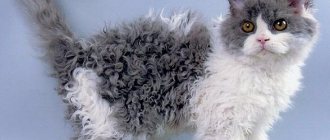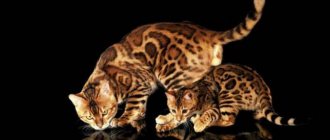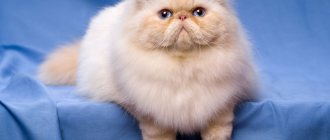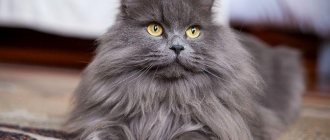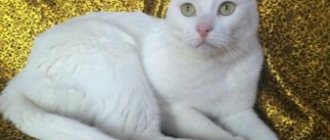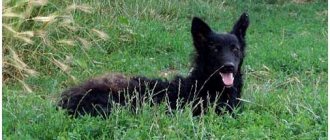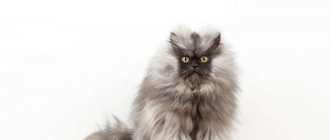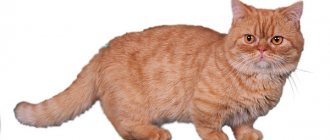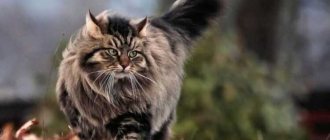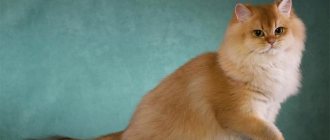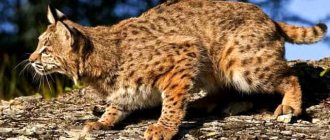Caracal
This beauty is kept at home
The average family does not keep caracals. The reason is the high cost of such a kitten: the cost starts at 450 thousand rubles.
Caracal is a native of Turkey. At least the country is considered the homeland of the animal. Over time, the wild cat spread to Africa, Arabia, India, etc.
Nowadays, wealthy people can afford to own a caracal. An animal with tassels on its ears requires space; representatives of the species are mobile, freedom-loving and very characteristic.
Externally, the caracal resembles a lynx: reddish coat color, rather long body, high ears with tassels. By the way, young animals have tassels that stand up, while older caracals droop and droop.
Breeders and owners of wild cats say that their pets are highly trainable, quickly get used to people and choose only one owner from all family members.
"Aborigines" from the Isle of Man
This is roughly the name given to the Manx cats that settled on the Isle of Man in the Irish Sea. How they got there is not known for certain, although there are many versions: from biblical to modern scientific.
Today there are 4 varieties of Manx. Depending on the length and shape of the tail, cats are divided into:
- Rampi (sacral). The tail is completely absent.
- Riser (growth). Instead of a tail, there is only a small protrusion on a couple of vertebrae. -9
- Stumpy (short). A small tail measuring 4-8 vertebrae.
- Longi (long). Quite a long tail, almost identical to the “classic” length.
- Rumpy
- Stumpy
- Riser
- Long
If we talk about character, animals are cheerful and energetic. They love active games, love to climb trees and have enviable jumping ability. The habits of cats are somewhat similar to dogs, in particular, this concerns learning various commands. Since Manx cats are very sociable, they are not recommended for people who are rarely at home.
Another distinctive feature of this breed is its excellent hunting qualities. Owners of such pets should be calm about the fact that prey in the form of mice, rats, moles and other garden and dacha “fauna” will be brought into the house. Manx cats will always find a common language with children, even when the baby is too persistent in showing his love and tormenting the cat with annoying caresses.
Caraquet
Wild beauty, but domestic character
Please do not confuse caracal and caracat. The former are wild predators, the latter are crossbreeds between a caracal and an ordinary cat.
There are several versions of the origin of the breed. According to the first, Caraquets are an accidental breed from Russia. Allegedly, in the late 90s, a caracal cat living in the Moscow Zoo mated an ordinary cat who, God knows, looked into his enclosure. Murka gave birth to a baby who looked like her father: the same color, facial expression and tufts on the ears. It was with him that the creation of a new breed began.
The American version of the origin of the breed says: in 2005, a breeder of Abyssinian cats bred one of her pets to a caracal cat. The result was the Caraquet breed.
Caracat is a large animal with the appearance of wild ancestors. A distinctive feature of the breed is its huge eyes and ears, decorated with tassels. Despite the presence of caracals in the pedigree, the descendants turned out to be affectionate, attached to humans and very cute. Breeders say that the caracat is a cat with the habits of a dog.
Origin of breed characteristics
The most interesting legend about the origin of the breed concerns one ancient cat whose tail was pressed under the door due to constant lateness. This action occurred regularly, so that each new litter of kittens was born with shorter tails, until the resulting appendage was reduced to a few vertebrae.
Since then, short-tailed cats have had creases and knots on their short stumps, which they inherited from their ancestors.
The following myth classifies representatives of short-tailed breeds as descendants of the lynx family. There are indeed common features in their appearance that can convince anyone of the validity of such conclusions. Even the chromosome map of two species contains 38 elements - the most important fact from supporters of such a theory.
The next hypothesis, unlike previous stories, looks more plausible. The kittens were born with normal tails, but the mother cats chewed them off because the cubs did not fit in the cramped den.
It was by the tail that the predator could pull the kitten out of the hole. Later, a natural mutation occurred, as a result of which short-tailed breeds appeared.
And the last version, which is related to genetics. By a strange coincidence, all tailless breeds originate either on island territories or in states with a closed way of life.
Representatives of the most ancient breed of cats with a short tail - Japanese Bobtails - came to the islands from Ancient China. For several centuries they lived in isolation. Under such conditions, it is possible to launch the natural process of inbreeding (inbreeding), which can cause genetic abnormalities.
At the other end of Europe, off the coast of Ireland, on the Isle of Man, a similar story happened. Here, local cats with short tails have been known for several centuries, but they only got outside their territory at the end of the 19th century, when they represented an already established and stable group.
Maine Coon
One of the largest breeds in the world
The breed is one of the largest in the world. It is not surprising, since the weight of an adult cat reaches 15 kg, and in combination with fluffy hair, tufts on the ears and a “brutal” facial expression, Maine Coons make an indelible impression.
Anyone who keeps representatives of this breed will not let you lie: “coons” are gorgeous! And we are not talking about the appearance of these animals at all, they also have an excellent character. With members of the family in which Maine Coons live, they are affectionate and talkative. Strangers are such an irritant; cats are wary of strangers. If a stranger who comes to the house for the first time decides to fraternize with its four-legged inhabitant, he risks getting a clawed paw on the hand, being scolded in cat language, or being bitten.
Varieties
There are more than 350 species of shrews. Only 25 of them are found in Russia. The most common types of long-nosed mice are:
- Common shrew. It can reach 8 cm in length, while its weight does not exceed 160 g. The body is covered with soft brown fur. A nose with a blunt tip is clearly visible on the head. The length of the animal's tail is equal to the length of its body.
- Tiny shrew. It got its name due to its very small size. Its weight is only 3 g, and its body length is 5 cm. The animal is recognized as the smallest representative of the mammal family. His nose is like a proboscis, and his short fur is gray-brown.
- House shrew or long-tailed shrew. This mouse can often be found in the vegetable garden or garden. For the winter, she moves to cellars or basements of private houses. The body length of this long-nosed mouse is about 8 cm, and the tail is up to 5 cm.
Tiny shrew
Short-tailed elf (Pixie-bob)
Terrible but cute elf
A hybrid of a forest cat and a domestic cat, the first mention of the breed appeared in the 80s of the last century in the USA. The breed was named after the first short-tailed kitten born as a result of mating a wild forest cat and an ordinary cat. The baby was named Pixie, which means “Elf”.
Elves look menacing: large body and head, frowning eyes, tufts on their ears - all this makes them look like their wild ancestors. In fact, pixie bobs are the kindest and most gentle creatures. Cats of this breed are much more attached to their owner than to other family members.
The peculiarity of the animals is not only their unusual exterior, but also the presence of extra toes on their paws. It is also extremely difficult for elves to get along with other cats, so it is recommended to have representatives of the breed as the only pet in the family.
Canadian Sphynx
One of the oldest breeds, which has won the hearts of people with its more than extraordinary appearance - an elongated, “faceted” muzzle, bare “velor” skin, the intelligent look of lemon-shaped eyes and huge ears, like those of a bat. The first “officially described” Sphinx lived in Ancient Egypt. A white blue-eyed cat guarded the Sanctuary of Ancient Egypt.
The Don and Petersburg (Peterbald) sphinxes are also “noble eared animals” with a naked body, although they are not relatives of the “Canadians”. Both breeds were developed in Russia, and the Peterbald was created by crossing the Don Sphynx and the Oriental cat.
Hairless cats have a “dog-like disposition” and require special care. Contrary to popular belief: “no hair, no problem,” caring for Sphynx cats is more problematic than caring for Angora or Persian cats. Daily skin cleansing, strictly balanced nutrition and clothing that protects the cat from hypothermia. The Sphinx is a child in need of care with the look of a sage and the appearance of an alien creature.
Norwegian Forest Cat
Feline perfection
A beauty originally from the Norwegian forests, who miraculously became an ordinary cat. According to ancient legend, guardians lived in the forests of Norway. No one had ever seen them, because the guardians moved between the trees at the speed of light. One day one of the guardians of the forest hesitated and his large, fluffy tail flashed between the trees. People saw this and immediately began vigorous activity to capture the forest guardian.
The guardians turned out to be beautiful cats. Huge, fluffy, with expressive eyes and tufts on the ears. The animals, at first, resisted, completely unwilling to be tamed. But time passed, cats learned to trust people, and the latter declared forest guardians as a new breed. This is how the Norwegian Forest Cat appeared.
Representatives of the breed are large (up to 9 kg), energetic and self-sufficient. Being hunters by nature, “Norwegians” do not get along well with other domestic animals. Especially with birds and rodents. Small breeds of dogs are regarded by Norwegian forest cats as a misunderstanding, not worthy of attention. Forest beauties tolerate their own kind, but with difficulty. It is better to have a Norwegian Forest Cat as your only pet.
Siberian
A strong, dense cat in a luxurious fur coat with a fluffy collar is the pride of Russian breeders. Siberians have muscular legs, large paws, a short wide head on a powerful neck and a gorgeous tail. You might think that their ancestors, like the ancestors of the Norwegians, lived somewhere in the taiga forests. And the name of the breed suggests such an idea. But this is not so: the ancestors of Siberians were ordinary mongrel cats, inhabitants of the streets in the cities of the European part of Russia.
The closest relatives of Siberians are Neva Masquerade cats. There is only one, albeit very noticeable, difference between them - color. It turned out that when the Siberian breed standard was being formed, all color point colors were banned. Not all breeders thought this decision was correct, but it was not possible to add them to the list of permitted breeders. Then enthusiasts developed a standard for another breed, which has not only its own “face”, but also many fans.
